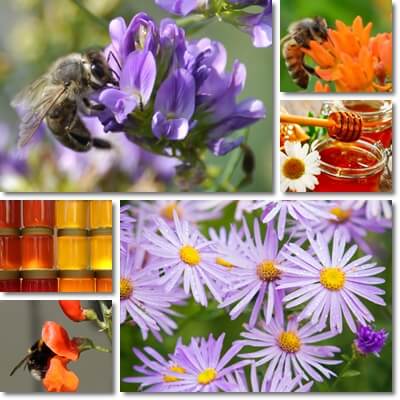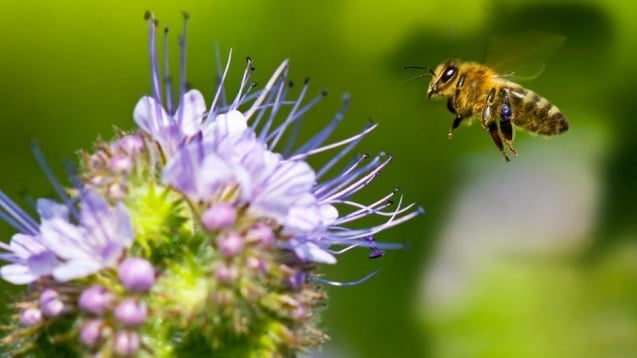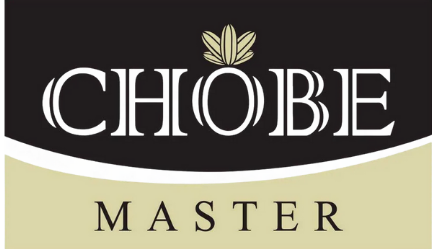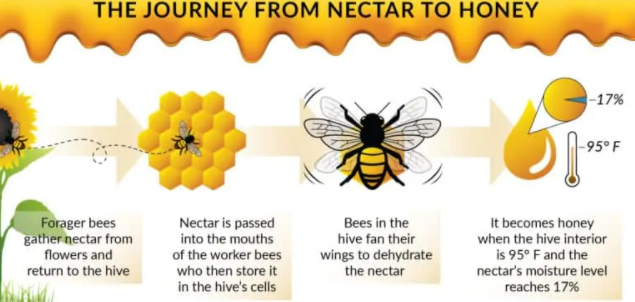
What is Honey?
A miraculous ingredient that’s made by bees entirely from sweet nectar of botanical origins, honey is nutritious, healthy and the best of all-natural sweeteners can be described as edible liquid gold. Once you realize just how special honey is, you’ll be buzzing about all its many varieties and benefits to everyone in your hive.
The Journey – Nectar to Honey
Stage 1: Worker Bees Collect Plant Nectar: Female workers are called foragers. They collect nectar from millions of blooming plants and store it in a type of extra stomach they have just for this purpose, called a crop.
Stage 2: Nectar Taken to the Hive: The bees get back to the hive and regurgitate the nectar, which has been processed with the enzymes in their crop and store it in one of the chambers of honeycomb in their hive.
Stage 3: Ripening the Honey:Nectar has a high moisture whereas honey does not. Bees place nectar or honey on comb and fan wings to remove the excess moisture.
Stage 4: Final Honey: Honey is formed and then stored in the cells of hives.

Types of Honey – Polyfloral and Monofloral
Much of the honey that’s available in shelves is polyfloral (multifloral) honey, meaning that contribution of the combines pollen from flower to flower resulting in a honey with richer taste and wider therapeutic use.

Main monofloral (unifloral) honey is made when, for example, the beehive is in a field of the same flowering tree or plant species. That’s when the honey begins to take on the flavor of one particular flower. Because every plant’s flower has a different smell, the honey also has a different taste based on what flower’s nectar it’s made with.
Health Benefits of Honey
- Natural energy source: Honey offers an easily absorbed supply of energy in the form of liver glycogen, making it ideal for energetic morning starts and as a pre- and post-exercise energy source.
- Wound and burn healer: Honey is used in medical settings to treat wounds because it’s been found to be an effective germ killer and also aids in tissue regeneration. Keep in mind that the honey used in hospital settings is medical grade, meaning it’s inspected and sterile. It’s not a good idea to treat cuts with honey you buy from a store.
- Replacing added sugar in the diet: Honey a natural sweetener is an ideal substitute for sugar in the diet.
- Soothe a sore throat: Honey is an old sore throat remedy. Simply add it to hot tea with lemon when a cold virus hits you. It also works as a cough suppressant.
- Help for digestive issues: Honey a potent prebiotic, meaning it nourishes the good bacteria that live in the intestines, which are crucial not only for digestion but overall health.
- Phytonutrient powerhouse: The phytonutrients in honey are responsible for its antioxidant properties. They’re also thought to be the reason pure honey has shown immune-boosting benefits.
 CHOBE – Pure Polyfloral Honey
CHOBE – Pure Polyfloral Honey
CHOBE Pure Polyfloral Honey originates from the nectar of plants that gathered, stored and dehydrated by the honey bee. CHOBE Pure Polyfloral Honey consists essentially of different natural sugars, with the predominant sugars being fructose and glucose. CHOBE Pure Polyfloral Honey is pure and free from additives, preservatives, noxious substances and admixtures of any kind including sucrose and invert sugars.
The Benefits of CHOBE – Pure Polyfloral Honey
- Stimulates appetite*
- Soothe sore throat*
- Aids digestion*
- Boosts the immune system*
- Stimulates wound healing*
* The information provided is informative in nature and is not substitute for the consultation, advice, treatment or prescriptions of specialist healthcare provider.
|
Appearance |
Viscous liquid, clear to slightly turbid. Free from sediment & crystallisation. |
|
Odour |
Pleasant, characteristic aroma. Free from foreign odours. |
|
Taste |
Pleasant, characteristic, sweet flavor, sufficiently strong but not distinctive. |
Organoleptic Characteristics
Nutritional Information
|
Energy |
358kcal |
|
Carbohydrate |
89.2g |
|
Protein |
0.3g |
|
Fat |
0.0g |
[Typical analysis per 100g. Average serving 1 Tbsp.(20g)]


